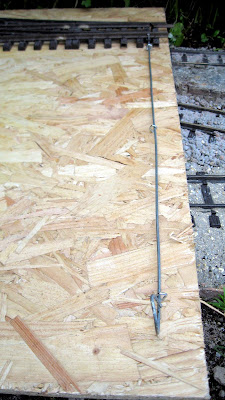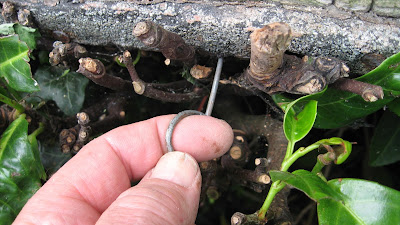Several years ago I bought a large coil of galvanised fencing wire from my local agricultural supplier. I was intending to add it to the top of a wooden fence as an additional deterrent for animals. However, like most jobs of this type, I never got around to it.
Recently I was trying to find a simple way of operating some points (turnouts) remotely and remembered that coil of wire .... surely it could be put to good use ..... ???
Galvanised fencing wire is very stiff and resistant to bending - which
makes it great for point rodding but tricky to manipulate. But, never willing to be defeated, I pressed on
Push-pull rodding
Ground level
A quick test rig was my first port of call - a length of wire and three screw eyelets to act as guides. I like to keep things simple.
Approximately 10mm at end of the wire was bent through 90° and flattened slightly by bashing it with a hammer so it would fit into the slot on the tiebar of the LGB R3 turnout.
A loop was bent at the other end after measuring the how long the rodding needed to be.
NOTE: As the wire is very stiff, I used a vice and a hammer to make the bends.
Three screw eyelets were then opened up slightly, by firstly screwing each one into my workbench ...
... and giving the eye a twist with a pair of pointed-nosed pliers.
The eyes need only to be opened sufficiently for the wire to slip in.
The eyelets were then screwed into the baseboard (if it had been concrete, I'd have drilled holes and inserted rawlplugs) and the wire threaded into them, before being squeezed closed again with the pliers.
The system clearly worked. As the wire is very stiff, the eyelets or 'stools' need only to be at around nine to twelve inch intervals (22 - 30cm).
Below baseboard level
The experiment was successful but I decided to install the rodding below baseboard level as the points which needed to be controlled were on the far side of the baseboard at Beeston Market and the rodding would have to cross the platform and several intervening tracks.
The same system was employed with a couple of slight modifications.
 |
Sorry about the poor photo, but it was dark under there!
|
Firstly, the bend at the turnout end of the rodding was extended to around 1½" (36mm) to allow it to reach the tiebar from below baseboard level.
Secondly, while drilling the slot for the lever, I snagged the slot on the tiebar, totally destroying it, and so I wrapped a loop of brass wire around the top of the lever and extended it beneath the tie bar to engage the slot on the opposite side.
The operating handle at the other end of the rodding was exactly as in the prototype
Below baseboard level - v2
At Beeston Castle, the tracks are mounted on concrete (breeze) blocks and when I recently relaid the tracks there, I took the opportunity to install some plastic tube in a shallow 'trench' beneath the platform and adjacent track.
The galvanised wire was a bit of a tight fit in the tube and so I used a length of 00 gauge nickel silver rail instead
The operating end of the rail was bent upwards to slot into the tiebar.
Twist point rodding
It's not always convenient for point rodding to be installed for push-pull operation without the need to a series of bell cranks to turn the motion through 90°. Whilst this would have been possible, I decided it was too fiddly to be fixed in place at the next location - the two points leading into the storage sidings in the lean to at Bickerton Station.
I then hit upon the idea of twisting the rodding rather than pushing and pulling it to transfer motion from the lever to the tie bar..
To give the required movement at the turnout end of the rodding, three bends needed to be made.
I found these quite tricky to form, as the wire is very stiff. After a couple of abortive attempts I discovered the easiest way to do it was to mark the wire at three half inch (12mm) intervals .....
.... form the innermost bend first in the vice, .....
.... followed by the middle bend and then the outermost bend.
A piece 9mm wide by 0.6mm thick brass strip (approximately 25mm long) was then trimmed to a blunt point at one end .....
..... before being wrapped around the wire on the middle bend.
This will connect the rodding to the slot in the tie bar by forming the pointed end into a hook
The other end of the rodding was bent into an operating lever and the eyelets were installed as previously.
As an be seen, the outermost eyelet was screwed into a rawlplug inserted into a hole in the brickwork of the lean to.
The rodding for the second point required a little more effort as it was more distant and fairly inaccessible without dismantling most of the shelving above the storage sidings. However, with a bit of grunting and a few curses, I hacked a chunk off the internal blockwork to allow it to cut the corner and then installed the system as previously
You may notice that I've ensured that the actuating levers lie flat. This is deliberate as, in the confined space, I don't want then to foul the stock as it emerges from the storage sidings.
Conclusion
I don't recall seeing this system described previously, but as it's very low tech way of solving the problem of operating turnouts remotely I'm sure I'm not the only person to have thought of it.
I would imagine that the twist system could be made to operate with gentle curves in the wire. I suppose it might also be possible to combine the two systems to turn a twist into a push-pull to turn the movement through 90°. The main limitation would be finding a way of bending the wire to make loops to connect one system to the other though I'm sure that other who are more dextrous and ingenious than me will not find it a problem.
My present system uses chrome plated steel eyelets. It would probably be better to use stainless steel eyelets though, at present, the only ones I can find are too large. I'm hoping I might be able to track down some smaller versions for my next application of the system - a lever frame at Bulkeley Station.



















































